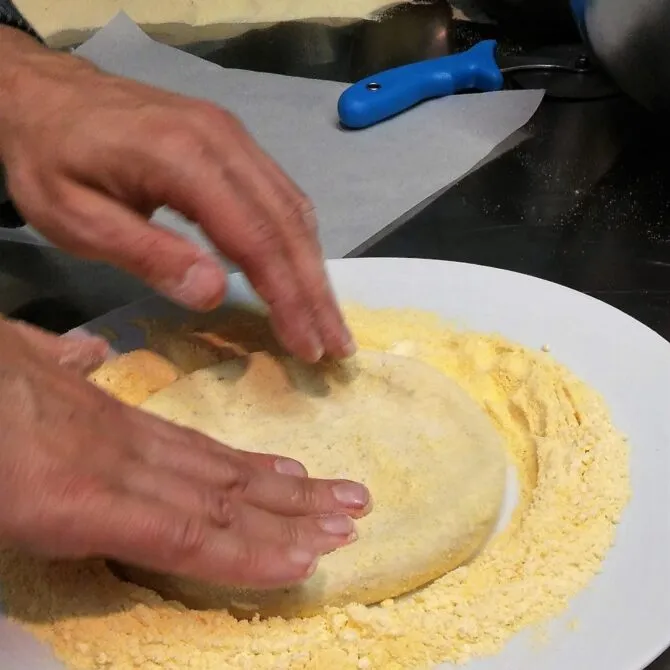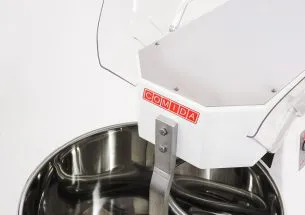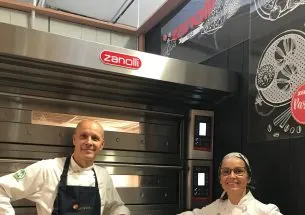We asked Federico De Silvestri, two-time World Champion in the Gluten-Free Pizza category, to give us his expert opinion on the use of supplementary ingredients or alternatives to wheat flour when making pizza. Zanolli accompanies you in discovering this universe…
Lupin, charcoal, beet, hemp, pea, spinach… trends or valid alternatives? Will they last?
Federico De Silvestri: Some of these flours, such as lupin and pea, but also buckwheat and teff (originating in Ethiopia and Eritrea) are used fairly frequently mainly, but not only, for gluten-free doughs. Rice flour can also supplement the mixture, with percentages around 5%, for both classic and gluten-free doughs. For example, it can make the ‘Pinsa Romana’ crunchier. Given the cost of some of these flours (hemp, teff), their use is often limited to gluten-free doughs. Of these, I would say that charcoal is a passing trend and is already in decline.
Are they really new or have some of them been rediscovered?
FDS: For those who have worked in the field for many years, most of these flours are not new. For some time certain pizza chefs have supplemented doughs with lupin, pea and teff flours to give a different texture, colour and, to a lesser extent, flavour. For example, chickpea flour is the essential element of the famous ‘farinata.
Do these ingredients have the most impact on the colour or taste? How about health?
FDS: In this case, it very much depends on the desired result. The juice is extracted from spinach, beetroot and carrots, for example, and this is added to the dough to simply change the colour, without an obvious change in terms of taste. Even cocoa powder, which I use for sweet pizzas, doesn’t have a strong presence in the flavour. If, instead, squid ink is used in the dough, you will no doubt obtain a more palatable result which must be taken into account when adding the toppings. There are however less cosmetic flours (lupin, pea, hemp, teff…) that actually enrich the dough and make it more healthy and natural from a certain point of view. Legume flours provide an interesting protein contribution. Let’s remember that these are still low percentages (3%, 5%…) and therefore it is essential that the rest of the mix is of high quality.
Does it also change the way that you top the pizzas?
FDS: I would say that the presence of ‘special’ ingredients rarely influences the topping of the pizza if the base isn’t coloured or doesn’t have an ingredient that adds flavour (such as squid ink). Pizza chefs who love experimenting with these ingredients usually also use specific products for the topping.
How can we use these ingredients optimally in order to get good results in terms of both appearance and flavour?
FDS: Be it gluten-free or classic doughs, the percentages to use of alternative flours or other elements are relatively low. It is essential to find the right balance, as well as to calibrate to local tastes. As regards specific doughs for those who are allergic or intolerant to gluten, preparation can be more complex: I prepare my gluten-free flour mixes myself. However, there are high quality ready-to-use mixes on the market. With experience pizza chefs acquire the ability to tame the elements and obtain fruitful interactions. Another type of ingredient that is often used in order to compensate for the lack of gluten comes from the family of starches: tapioca starch, guar gum, etc. serve to bind and act as a glue.
Are there any special indications for using machinery and ovens when these ingredients are used?
FDS: When it comes to gluten-free doughs, made with harder flours, we must compensate for the lower elasticity with higher heat. In the workshop of my pizzeria I have a corner dedicated to gluten-free. Generally I adjust the settings of the Zanolli Citizen oven with a cooking time of around 4/4.5 minutes (instead of 3.5-4 minutes for classic pizza), at a temperature of 345°, with a power of 90% on the top and 50% on the bed plate. In any case, the cooking temperature and time depend not only on the presence of gluten in the flour, but also on the hydration and the degree of refinement of the flour. The more it is refined, the less water is needed in the dough. The presence of ‘special’ ingredients in a classic mix at low percentages does not change the cooking method much.
Do you have any advice you want to share on the use of ‘alternative’ flours?
FDS: Even in the world of wheat flour, you can experiment with various hardnesses and textures. With a mixture of 00 flour (about 70%), type 1 stone-ground flour (about 15%) and wholemeal flour (about 15%), you can obtain a more colourful, crunchy and tasty pizza base.
We asked Federico De Silvestri, two-time World Champion in the Gluten-Free Pizza category, to give us his expert opinion on the use of supplementary ingredients or alternatives to wheat flour when making pizza. Zanolli accompanies you in discovering this universe…
Lupin, charcoal, beet, hemp, pea, spinach… trends or valid alternatives? Will they last?
Federico De Silvestri: Some of these flours, such as lupin and pea, but also buckwheat and teff (originating in Ethiopia and Eritrea) are used fairly frequently mainly, but not only, for gluten-free doughs. Rice flour can also supplement the mixture, with percentages around 5%, for both classic and gluten-free doughs. For example, it can make the ‘Pinsa Romana’ crunchier. Given the cost of some of these flours (hemp, teff), their use is often limited to gluten-free doughs. Of these, I would say that charcoal is a passing trend and is already in decline.
Are they really new or have some of them been rediscovered?
FDS: For those who have worked in the field for many years, most of these flours are not new. For some time certain pizza chefs have supplemented doughs with lupin, pea and teff flours to give a different texture, colour and, to a lesser extent, flavour. For example, chickpea flour is the essential element of the famous ‘farinata.
Do these ingredients have the most impact on the colour or taste? How about health?
FDS: In this case, it very much depends on the desired result. The juice is extracted from spinach, beetroot and carrots, for example, and this is added to the dough to simply change the colour, without an obvious change in terms of taste. Even cocoa powder, which I use for sweet pizzas, doesn’t have a strong presence in the flavour. If, instead, squid ink is used in the dough, you will no doubt obtain a more palatable result which must be taken into account when adding the toppings. There are however less cosmetic flours (lupin, pea, hemp, teff…) that actually enrich the dough and make it more healthy and natural from a certain point of view. Legume flours provide an interesting protein contribution. Let’s remember that these are still low percentages (3%, 5%…) and therefore it is essential that the rest of the mix is of high quality.
Does it also change the way that you top the pizzas?
FDS: I would say that the presence of ‘special’ ingredients rarely influences the topping of the pizza if the base isn’t coloured or doesn’t have an ingredient that adds flavour (such as squid ink). Pizza chefs who love experimenting with these ingredients usually also use specific products for the topping.
How can we use these ingredients optimally in order to get good results in terms of both appearance and flavour?
FDS: Be it gluten-free or classic doughs, the percentages to use of alternative flours or other elements are relatively low. It is essential to find the right balance, as well as to calibrate to local tastes. As regards specific doughs for those who are allergic or intolerant to gluten, preparation can be more complex: I prepare my gluten-free flour mixes myself. However, there are high quality ready-to-use mixes on the market. With experience pizza chefs acquire the ability to tame the elements and obtain fruitful interactions. Another type of ingredient that is often used in order to compensate for the lack of gluten comes from the family of starches: tapioca starch, guar gum, etc. serve to bind and act as a glue.
Are there any special indications for using machinery and ovens when these ingredients are used?
FDS: When it comes to gluten-free doughs, made with harder flours, we must compensate for the lower elasticity with higher heat. In the workshop of my pizzeria I have a corner dedicated to gluten-free. Generally I adjust the settings of the Zanolli Citizen oven with a cooking time of around 4/4.5 minutes (instead of 3.5-4 minutes for classic pizza), at a temperature of 345°, with a power of 90% on the top and 50% on the bed plate. In any case, the cooking temperature and time depend not only on the presence of gluten in the flour, but also on the hydration and the degree of refinement of the flour. The more it is refined, the less water is needed in the dough. The presence of ‘special’ ingredients in a classic mix at low percentages does not change the cooking method much.
Do you have any advice you want to share on the use of ‘alternative’ flours?
FDS: Even in the world of wheat flour, you can experiment with various hardnesses and textures. With a mixture of 00 flour (about 70%), type 1 stone-ground flour (about 15%) and wholemeal flour (about 15%), you can obtain a more colourful, crunchy and tasty pizza base.
You might also be interested in...





